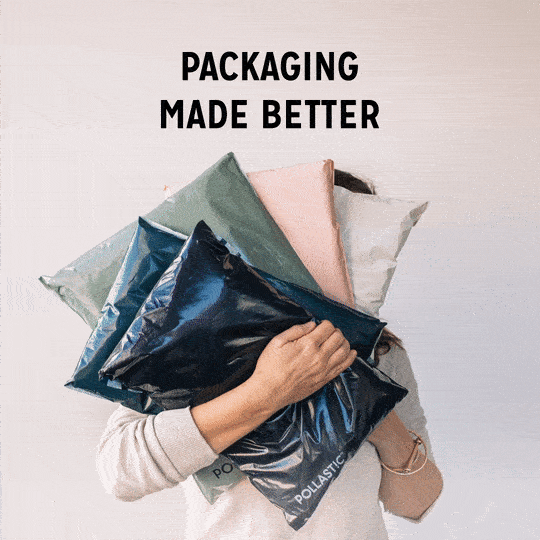The Status Quo with sustainable packaging
Over the last 4 years we have seen a fundamental shift in consumer expectations around sustainable ecommerce packaging. Pre 2018, there were very few commercially available options for e-commerce retailers with most resorting to using plastic mailing satchels made from virgin plastic. They were cheap and robust but catastrophic for the environment. With a vision for a more environmentally friendly world, pioneers like Better Packaging Co. and Hero Packaging stepped into this gap by developing bio-degradable (home compostable) mailers partly made from plants – corn starch in fact. Their products were so disruptive that they shaped consumer expectations to the point where now almost every E-commerce retailer uses sustainable packaging of some variety. Even some of the most established E-fulfilment businesses like Australia Post have had to follow suit, now offering sustainable packaging options as well.
“Cornstarch mailers have fundamentally changed the ecommerce landscape for the better.”
The Challenge with Corn-starch Packaging
Corn-starch mailers were an amazing step forward, and much better than anything available prior to their release, but they are still far from a perfect solution. There are still some areas for improvement:
Environmental Concerns
- Corn-starch mailers are made from polylactic acid (PLA), which in the right composting conditions (warmth, moisture, microbes and oxygen) will rapidly break down to water and C02, but if sent to a commercial landfill may last as long as a normal plastic water bottle. If they do begin to break down under anaerobic conditions (landfills are not designed to have oxygen circulating), they will release methane, a potent greenhouse gas.
- As well as cornstarch and PLA (derived from corn), these mailers are also made from PBAT which is derived from petroleum.
- PLA based products disposed of into recycling waste streams designed for normal PET plastic can contaminate the stream, resulting in plastic going to landfill that could have otherwise have been recycled.
Fit for purpose concerns
- Shipping mailers must be fit for purpose, if the contents of a package are damaged (or even worse, lost) during transit, then the carbon cost of resending a second item renders the benefits of using a more environmentally friendly mailer pretty much redundant. Unfortunately, corn-starch mailers have proven less durable than their predecessors.
- The nature of the resins used to make corn-starch mailers mean that they are less stable than standard plastic mailers and, because of this they have a limited shelf life before they become too weak.
- From our own experience, shipping labels just don’t stick all that well to corn-starch mailers either which can result in lost packages within the postal/courier networks. After speaking with our Australia Post account manager, it has become apparent that this is a known problem.
Ethical Concerns
- The ethics around using a food base (corn) for packaging when there are so many places in the world without reliable access to food is a little murky.
- Corn used for corn-starch mailers are often produced from GMO corn (although those from Better Packaging Co. are certified to be GMO free).
The Next Evolution for Ecommerce Packaging
As a 3PL with a genuine concern for sustainability, we were really excited to find out about Better Packaging Co’s new POLLAST!C range. Rather than using virgin materials to make the mailers they use recycled ocean bound plastic. That is, plastic which if not rescued will end up as pollution in the ocean causing massive ecological harm.
Here’s a comparison between the standard corn-starch mailers and Better Packaging Co.’s POLLAST!C ocean-bound-plastic mailers:
| Concern | Corn-starch | POLLAST!C |
|---|---|---|
| Landfill breakdown times | Long breakdown times in landfill, Ultra short breakdown times in compost | Long breakdown times in Landfill (but at least its not not in the ocean anymore!) |
| Recycling stream contamination | Potential recycling stream contamination | No Issue |
| Strength of mailer | Weaker than plastic mailers resulting in increased lost/damaged shipments | Equivalent strength to plastic mailers |
| Product Stability | 6-12month shelf life | No shelf life limit |
| Shipping label adhesion | Poor, particularly during colder months | Great adhesion |
| Ethical | Potential concerns around food being diverted to satchels | Recovering the plastic is also done in a way that provides jobs for underprivileged coastal communities |
| GMO Considerations | Can be GMO promoting | No Issue |
| Material Inputs | PLA made from corn PBAT made from petroleum | No Virgin content – 100% recycled |
POLLAST!C is by no means a panacea for packaging, the best solution will always be a product that isn’t single use. But until that is reasonably practicable in today’s fast paced ecommerce world, POLLAST!C is by far the next best option and clearly addresses a lot of the limitations inherent with corn-starch satchels.
It is our plan over the next couple of quarters to phase out our use of corn-starch products in favour of POLLAST!C mailers instead, with the exception of clients who specifically require corn-starch mailers as part of their brand identity. To learn more about the other services we offer as a 3PL, check out our services page.




